Risk Management for NGOs
Added on 2023-05-26
21 Pages3658 Words394 Views
Running Head: NGOs RISK MANAGEMENT 0
Risk Management for NGOs
Risks Analysis Identification and Management for NGOs
(Student details :)
12/19/2018
Risk Management for NGOs
Risks Analysis Identification and Management for NGOs
(Student details :)
12/19/2018
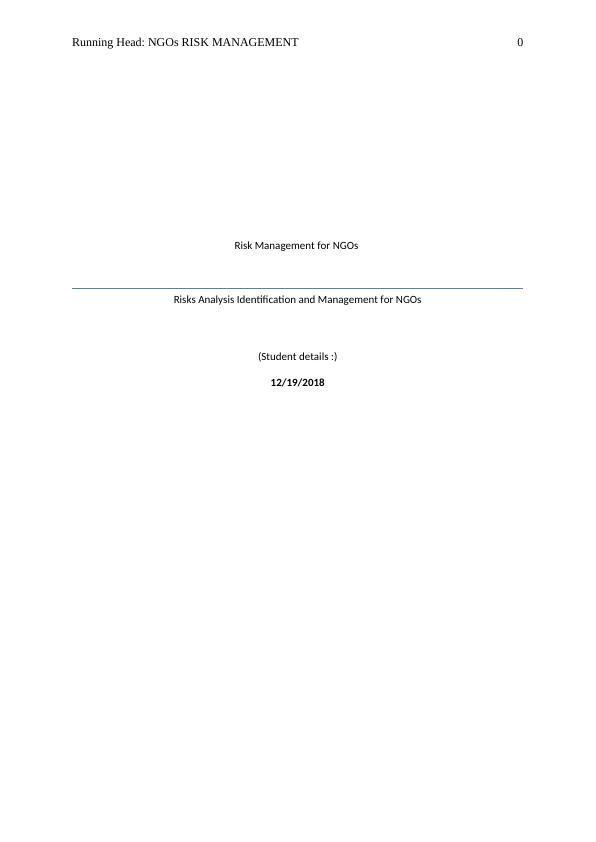
NGOs Risk Management 1
Contents
Risk Management for NGOs......................................................................................................2
Introduction................................................................................................................................2
Description.................................................................................................................................3
General Analysis........................................................................................................................5
Actualization..............................................................................................................................7
Recording risks information...................................................................................................8
Discussion................................................................................................................................10
Pros of RM for NGOs..........................................................................................................12
Cons of RM for NGOs.........................................................................................................13
General recommendations........................................................................................................15
Conclusion................................................................................................................................16
Contents
Risk Management for NGOs......................................................................................................2
Introduction................................................................................................................................2
Description.................................................................................................................................3
General Analysis........................................................................................................................5
Actualization..............................................................................................................................7
Recording risks information...................................................................................................8
Discussion................................................................................................................................10
Pros of RM for NGOs..........................................................................................................12
Cons of RM for NGOs.........................................................................................................13
General recommendations........................................................................................................15
Conclusion................................................................................................................................16
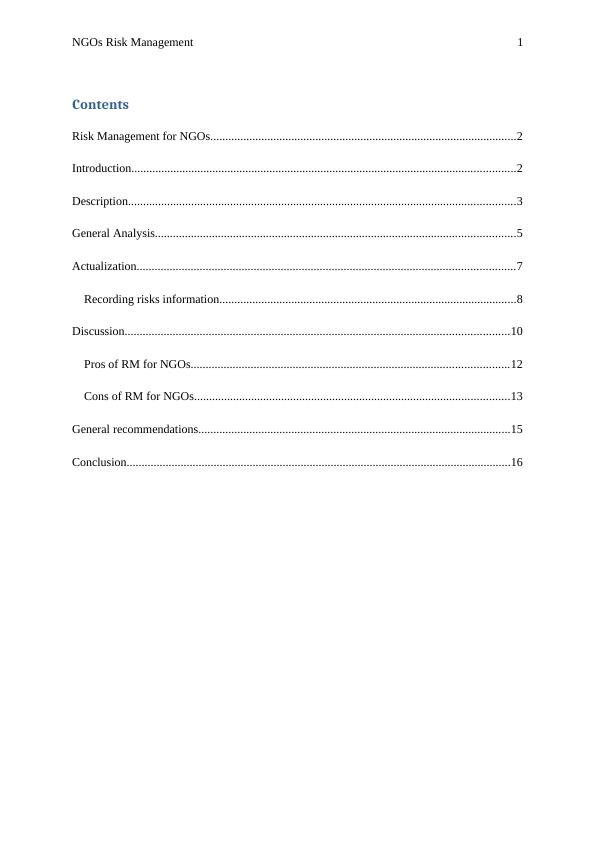
NGOs Risk Management 2
Risk Management for NGOs
Introduction
This essay is focused on identification of probable risks occurred for NGOs while
implementing projects along with providing strategies or solutions for mitigating those risks
effectively. As we know that Non-government Organizations (herein after referred as NGOs)
are functioning in a specific environment like conflicts, poverty, natural disaster, under
donors funds and restrictions, local government rules, compliance between international and
national laws are facing so many risks hence this discussion is an attempt for assessing those
risks and finding their effective solutions (AustralianGovernment, 2008).
Risk can be defined as the common thinking about what might go wrong in a NGO or
any other organization (Gartner, 2018). In this context, more precise definition of risk is ‘the
effects of uncertainty on NGOs objectives’. With the change in an internal dynamics as well
as external environment in which an organization operates, potential risks arrive, vanish or
evolve. Hence risk management is the process of coordinated activities for controlling or
reducing risks. During risk management (RM), anticipating risks is the first step, then it aims
at averting risks and finally at optimizing risks’ impact if they do happen (Colquitt, Lepine,
Wessaon, & Gellatly, 2011).
In this way, this document is a direction for all those NGOs staff includes directors,
directors, senior staff, managers and any other staff who really want to manage their risks as
well as work well (SHF, 2018). This discussion will help in formulating a risk management
framework or policy for identifying, monitoring as well as managing risks in NGOs by
providing a step-by-step approach. Step-by-step approach may contain description, general
Risk Management for NGOs
Introduction
This essay is focused on identification of probable risks occurred for NGOs while
implementing projects along with providing strategies or solutions for mitigating those risks
effectively. As we know that Non-government Organizations (herein after referred as NGOs)
are functioning in a specific environment like conflicts, poverty, natural disaster, under
donors funds and restrictions, local government rules, compliance between international and
national laws are facing so many risks hence this discussion is an attempt for assessing those
risks and finding their effective solutions (AustralianGovernment, 2008).
Risk can be defined as the common thinking about what might go wrong in a NGO or
any other organization (Gartner, 2018). In this context, more precise definition of risk is ‘the
effects of uncertainty on NGOs objectives’. With the change in an internal dynamics as well
as external environment in which an organization operates, potential risks arrive, vanish or
evolve. Hence risk management is the process of coordinated activities for controlling or
reducing risks. During risk management (RM), anticipating risks is the first step, then it aims
at averting risks and finally at optimizing risks’ impact if they do happen (Colquitt, Lepine,
Wessaon, & Gellatly, 2011).
In this way, this document is a direction for all those NGOs staff includes directors,
directors, senior staff, managers and any other staff who really want to manage their risks as
well as work well (SHF, 2018). This discussion will help in formulating a risk management
framework or policy for identifying, monitoring as well as managing risks in NGOs by
providing a step-by-step approach. Step-by-step approach may contain description, general
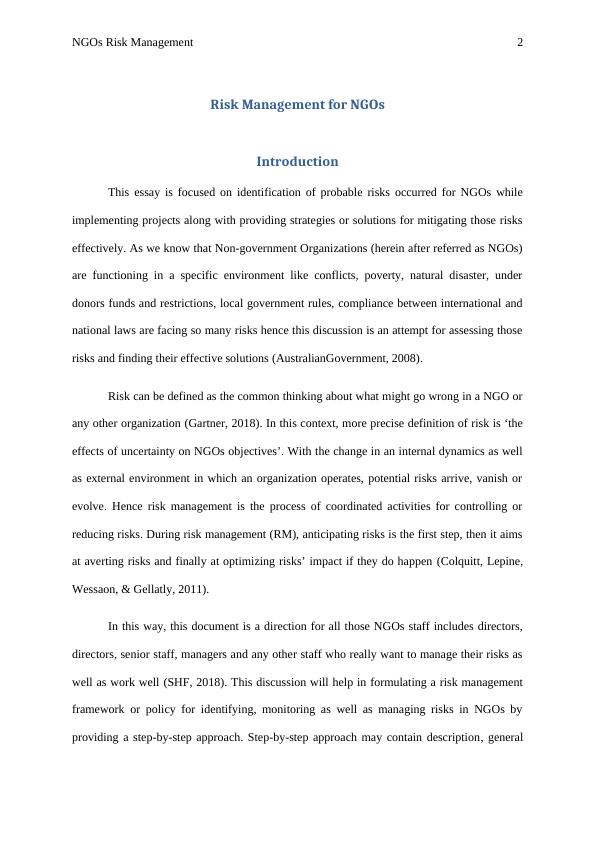
NGOs Risk Management 3
analysis, actualization, discussion, general recommendations as well as summary of the
discussion (Designingbuildingswiki, 2018).
Source: (Careersin Audit, 2013)
Description
S. No. Step Key components
Building the context Organizations objectives taking into account
Identification of stakeholders
Identification of risk criteria
Identification of risk assessment criteria (United Nations
Somalia, 2018).
Risk assessment What, when and how about the risks
Potential cost to money, time, and performance
analysis, actualization, discussion, general recommendations as well as summary of the
discussion (Designingbuildingswiki, 2018).
Source: (Careersin Audit, 2013)
Description
S. No. Step Key components
Building the context Organizations objectives taking into account
Identification of stakeholders
Identification of risk criteria
Identification of risk assessment criteria (United Nations
Somalia, 2018).
Risk assessment What, when and how about the risks
Potential cost to money, time, and performance
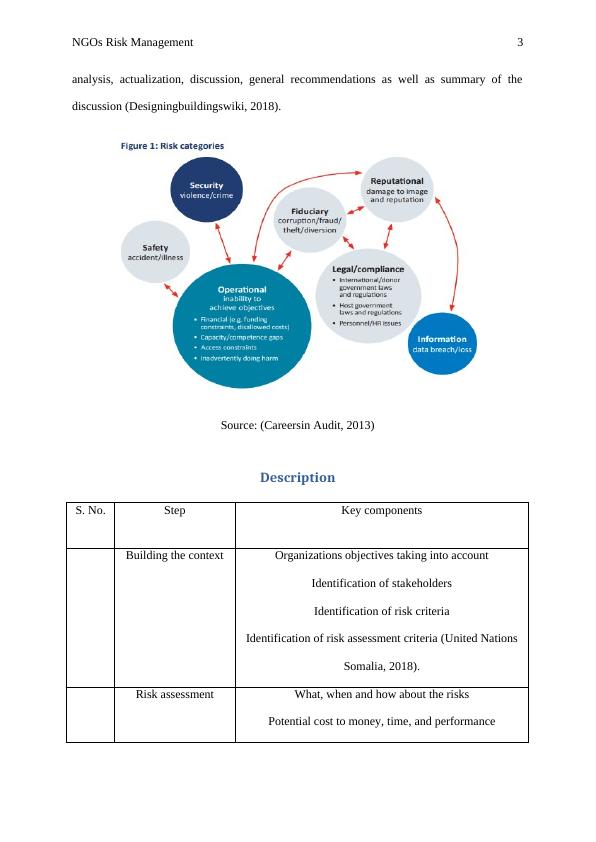
NGOs Risk Management 4
Impacts of each risk
Source of the risk
Risk analysis Analysis of existing controls
Consequences of the risk been considered
Application of likelihood criteria
Development of risk matrix
Risk evaluation Comparison of the risk against se criteria
Development of guidelines about retention and escalation
Making decision for treating risk
Continue monitoring and reviewing risk
Risk treatment Identification of treatment options
Assessment of all treatment options
Implementation of treatment plans
Analysis and evaluation of residual risks
Consideration of consultation and communication
requirements (Reference for Business, 2018).
The modern world’s environment in which NGOs are operating is evolving quickly,
as is the process of the risk management functions as well as the procedure of making
decisions about risks (Chenhall, Hall, & Smith, 2010). The changes of the modern world are
affecting not only NGOs but also the community which is served and the organizations those
are funding them (Clarke, 2017). For the NGO’s success in terms of executing their mission
as well as accomplishing their long-term goals, NGOs must keep pace with modifications in
the whole political, economic and cultural environment of the risk management practice so
Impacts of each risk
Source of the risk
Risk analysis Analysis of existing controls
Consequences of the risk been considered
Application of likelihood criteria
Development of risk matrix
Risk evaluation Comparison of the risk against se criteria
Development of guidelines about retention and escalation
Making decision for treating risk
Continue monitoring and reviewing risk
Risk treatment Identification of treatment options
Assessment of all treatment options
Implementation of treatment plans
Analysis and evaluation of residual risks
Consideration of consultation and communication
requirements (Reference for Business, 2018).
The modern world’s environment in which NGOs are operating is evolving quickly,
as is the process of the risk management functions as well as the procedure of making
decisions about risks (Chenhall, Hall, & Smith, 2010). The changes of the modern world are
affecting not only NGOs but also the community which is served and the organizations those
are funding them (Clarke, 2017). For the NGO’s success in terms of executing their mission
as well as accomplishing their long-term goals, NGOs must keep pace with modifications in
the whole political, economic and cultural environment of the risk management practice so

NGOs Risk Management 5
that understanding of risks can be illustrated. Hence risk management is a strategic challenge
today (DepartmentofLabour, 2002). Service or social change oriented NGOs always need to
operate in the dynamic, political, economic, technological, as well as institutional
environments hence the risk associated with them are huge. Besides, questions about their
effect on society raised by stakeholders, the broader society as well as the governments in
front of NGO leaders is also a big challenge for the NGOs (Sadgrove, 2016).
In this way, risk management allow NGOs to modify the way they respond to the
society and the world as well as seek to form it. As a result, several development NGOs are
changing their strategies so that risks can be mitigated in an effective way as well as NGOs
are changing their functioning strategies more often than in the previous eras. Thus, for
NGOs, modification is apparently essential; each NGO’s mission statement promises it for
improving some undesirable aspects of the modern world. However, change will bring
uncertainty as well as risk in the path which has to be prevented and resolved (Reddy, 2018).
General Analysis
Risks identification, analysis as well as effective management in NGOs contribute to
compliance as well as good governance. Further, an effective risk management can contribute
to a strategic typical running as well as business planning of the NGOs. It creates confidence
among NGOs staff so that they can assist in delivering desired outcomes, making informed
decisions about opportunities as well as managing threats to the acceptable extent (National
science foundation, 2008).
Hence, some key benefits of risks management in NGOs are as follows:
RM prepares the NGO for challenging events
RM prepares the NGOs for improving overall resilience
that understanding of risks can be illustrated. Hence risk management is a strategic challenge
today (DepartmentofLabour, 2002). Service or social change oriented NGOs always need to
operate in the dynamic, political, economic, technological, as well as institutional
environments hence the risk associated with them are huge. Besides, questions about their
effect on society raised by stakeholders, the broader society as well as the governments in
front of NGO leaders is also a big challenge for the NGOs (Sadgrove, 2016).
In this way, risk management allow NGOs to modify the way they respond to the
society and the world as well as seek to form it. As a result, several development NGOs are
changing their strategies so that risks can be mitigated in an effective way as well as NGOs
are changing their functioning strategies more often than in the previous eras. Thus, for
NGOs, modification is apparently essential; each NGO’s mission statement promises it for
improving some undesirable aspects of the modern world. However, change will bring
uncertainty as well as risk in the path which has to be prevented and resolved (Reddy, 2018).
General Analysis
Risks identification, analysis as well as effective management in NGOs contribute to
compliance as well as good governance. Further, an effective risk management can contribute
to a strategic typical running as well as business planning of the NGOs. It creates confidence
among NGOs staff so that they can assist in delivering desired outcomes, making informed
decisions about opportunities as well as managing threats to the acceptable extent (National
science foundation, 2008).
Hence, some key benefits of risks management in NGOs are as follows:
RM prepares the NGO for challenging events
RM prepares the NGOs for improving overall resilience
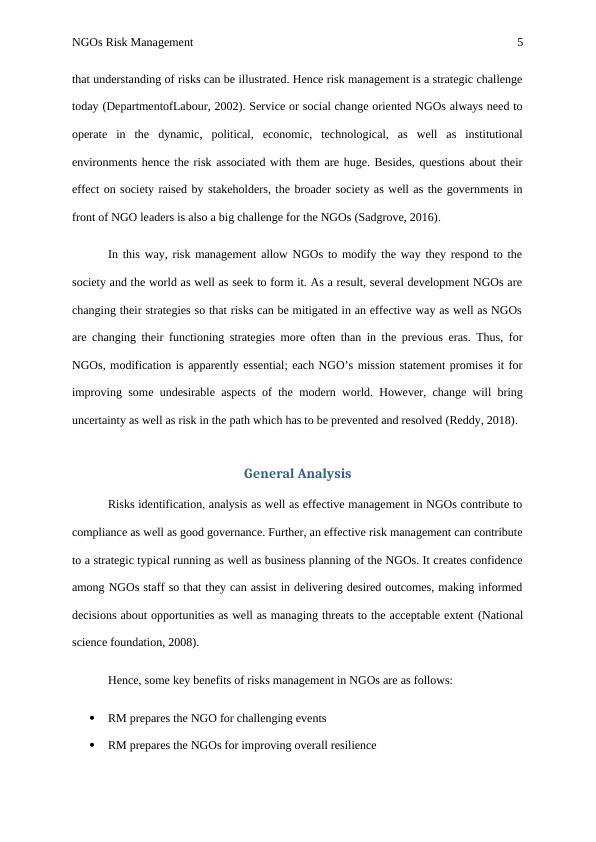
End of preview
Want to access all the pages? Upload your documents or become a member.
Related Documents
Business Risk Managementlg...
|17
|4547
|239
Risk Management Plan Templatelg...
|12
|2712
|84
Building of a Melbourne to Sydney High Speed Rail System: A Risk Management Planlg...
|18
|969
|497
Security Management and Governancelg...
|7
|1663
|87
Risk Analysis and Management: ABC Pvt Ltd Companylg...
|46
|14654
|484
Strategies for Monitoring and Improving Quality Customer Service at Qantas Airlinelg...
|5
|1686
|375
